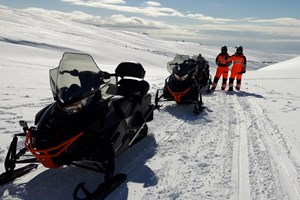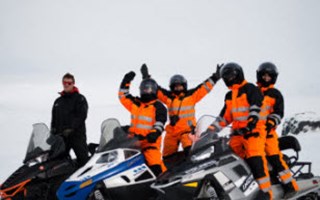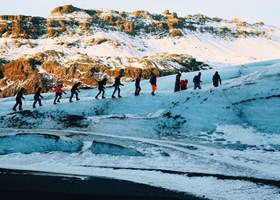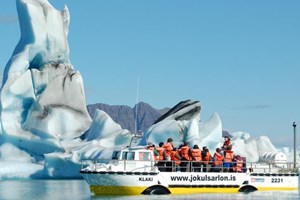The Volcano Katla
The volcano Katla is located underneath Mýrdalsjökull in the southern part of Iceland. Katla has been a very active volcano since Iceland was settled, the third most active volcano on the island. Katla has erupted on average once every 60 years. The last big eruption in Katla was in 1918 but since then it is thought possible that Katla has erupted three times. First in 1955 but then a glacier flood came from underneath Kötlujökull (Katla glacier) into the river Múlakvísl. In 1999 when a glacier flood came from underneath Sólheimajökull. And the last one was in 2011 when a glacier flood came from beneath Kötlujökull into Múlakvísl, this flood was so powerful that it destroyed the bridge over Múlakvísl.
These three minor eruptions in Katla since 1918 all have in common that they did not manage to get through the ice cap. They melted the ice from below and therefore glacier floods occurred. Some large caldera formed on the surface of the glacier because of those eruptions.
The current period, from the last big eruption in Katla, has now lasted 99 years. This is the longest time Katla has not erupted since the settlement of Iceland. In the past year Katla has been rather restless and many strong earthquakes have occurred in its caldera since last autumn. The first sign of eruption in Katla has often been strong earthquakes.
In old annals and histories, it is mentioned that the inhabitants around Vík í Mýrdal felt earthquakes few hours before the eruption came through the glacier. Due to how long it has been since there was a large eruption in Katla no statistic measurements are available and therefore it is difficult for scientists to say how the prelude to eruption will be.
History of Katla
From the settlement of Iceland fairly good information is available about eruptions in Katla. As aforesaid it is believed that Katla has erupted at least 20 times since the settlement in 874. It is believed that there was a very big eruption in Katla from 932 to 936. At the same time, there was an eruption in Eldgjá. Eldgjá is a very long volcanic fissure, 50 to 70 km long, that runs northeast from Katla towards Vatnajökull. Eldgjá is parallel with Lakagígar that formed in eruption in 1783. The lava flow in this eruption was enormous or 20 cubic kilometres. This is by far the most amount of lava in one eruption in Iceland since the settlement. This lava is tens of meters thick in some places. It flowed over Álftaver and down Mýrdalssandur, east of Hjörleifshöfði.
Another eruption in Katla that is worth mentioning, is the one that begun on October 17th 1755. It lasted until 13th of February 1756 or 118 days. Much ash fell during this eruption and it is believed that at least 50 farmlands were deserted because of the eruption. Two person got killed during the eruption when they were hit by a lighting. Huge glacier flow came from underneath Kötlujökull as a result of the eruption. It poured over Mýrdalssandur and Vík í Mýrdal.
The eruption in 1918
As aforesaid the last big eruption in Katla was in 1918. The eruption started on October the 12th and lasted until November the 4th. Great glacier flood poured down Mýrdalssandur. The plume of ash reached as high as 14 km and lightings occurred 20 to 25 km above the ground. It is estimated that the total amount of volcanic ash during this eruption was 700 million cubic meters.
Katla is monitored closely
All changes in the volcano itself and the area close to it are now closely monitored. Earthquakes are monitored as they can indicate that magma is on the move in the underground. Expansion in the crust is also measured as it can indicate that more magma is concentrating in volcanic system and its magma chamber. Outflow of gas from Katla is also measured and the chemical composition of thermal water that comes from beneath glaciers like Sólheimajökull and Kötlujökull is also monitored. Changes in the flow of gas and the chemical composition of thermal water could be signs of increased volcanic activity that could result in eruption.
There is much geothermal energy in the Katla volcano. 18 geothermal areas are known to exist underneath Mýrdalsjökull. Those areas are located in the Katla caldera, their activity is different but signs of them can be seen in the form of caldera in the surface of the glacier. Those areas are monitored and changes in the calderas are measured and monitored. Great changes in those areas can indicate increase volcanic activity in the Katla volcano.
Those forerunners can give scientists indication that Katla is preparing to erupt. It is very important for people around the town of Vík to get information about possible eruption as soon as possible so they can be evacuated and moved to safe place before the eruption begins with powerful glacier floods and ash fall.
Facts about Katla
Katla is a volcano that has developed in the last hundreds of thousands of years. It can be estimated that the volcano is at least 200.000 years old. In this period the volcano has changed a lot and developed. It is believed that the caldera of the volcano formed around 12.400 years ago when a great eruption took place. Scientist have come to this conclusion by analysing samples of ash that were extracted from ice in Greenland. Those samples did also show that big eruptions had occurred in Katla around 70.000 to 80.000 years ago.
The second biggest Icelandic volcano caldera is located in the Katla volcano. The caldera is thought to be around 110 square kilometres. Only the caldera of Torfajökull, close to Landmannalaugar, is thought to be bigger. The edges of the Katla caldera reach up to over 1.300 meters over sea level but the bottom is around 640 meters of sea level. The caldera is therefore around 600 to 700 meters deep where it is deepest. The caldera is full of glacier ice as Mýrdalsjökull covers it.
Katla and the Glacier Floods
When the Katla volcano erupts huge amounts of glacier ice melts in a very short time. It is estimated that Mýrdalsjökull is up to 750 meters thick. It is thought that it will only take 2-3 hours for an eruption to melt its way through the glacier. When it happens, a lot of water gathers in the place where the eruption occurs. At a certain time, the glacier can’t stand all this amount of water and breaks. Then the water scrambles from underneath the glacier and towards the ocean.
It has been estimated that the amount of water can be up to 500.000 cubic meters pr. second. This is more than double the amount of water in the Amazon which is around 200.000 cubic meters pr. second. When the last big glacier flood came from underneath Mýrdalsjökull, in 1918, it is estimated that the coastline moved 2 to 3 km to the south on the south side of Hjörleifshöfði. This new land is named Kötlutangi and was the most southern part of Iceland at that time. This new land has worn away due to the effects of the ocean.
The glacier floods from Katla have come from three of Mýrdalsjökull icefalls. Most often they have come from underneath Kötlujökull that flows down to the lowland southeast from underneath Mýrdalsjökull east of Vík í Mýrdal. Glacier floods can also come from underneath Sólheimajökull which flows down from the southern part of Mýrdalsjökull between Skógar and Vík í Mýrdal.
The third option for glacier floods is from underneath Entujökull which flows down from Mýrdalsjöklull to northeast. The last big glacier flood that came from beneath Entujökull occurred around 1.500 years ago, then the water flooded past Þórsmörk and west of Hvolsvöllur. Evidence of that flood can be found in Fljótshlíð where there are broken trees that have emerged from the sand in the Drumbabót area. There is evidence of a forest in that area when this happened.<
Glacier floods from Katla have constructed the black sands at the coast around Vík í Mýrdal since the last ice age ended around 11.000 years ago and will most likely continue to do so.
Folktales
Katla (Kötlu) is a women’s name but in 2017 it was the given name of around 250 women.
According to old folktales a woman named Katla (Kötlu) lived at Þykkvabæjarklaustur between Vík í Mýrdal and Kirkjubæjarklaustur. She was housekeeper in the monastery and was thought to have supernatural powers. Among other things she owned trousers that allowed her to run without getting tired. Once, Katla went to a feast at Kirkjubæjarklaustur with the abbot. While they were at the feast worker, named Barði, at the farm went to gather the sheep and get them back to the farm. This was a difficult task for Barði but he knew that Katla would get very angry and punish him if he did not succeed in finding all the sheep and get back to the farm. He knew that Katla had the magic trousers so he went back to the farm and took the trousers and put them on. This allowed him to run all over and find the sheep and get them back to the farm. He then returned the trousers to the place he took them from and thought that the case was closed.
When Katla returned she saw that Barði had taken her trousers, she walked towards him and killed him. Then she threw his body into a vat where soured meet was stored. When it came closer to spring the surface in the vat got lower and Katla was worried that the body might soon surface. One day she took her trousers and ran straight up to Mýrdalsjökull and was seen disappear into the glacier.
Soon afterwards a great glacier flood came from the glacier. People thought it was because of Katla showing her anger and that it was her fault if the glacier erupted.
Katla and the famous Eyjafjallajökull
It is worth mentioning that Katla has often erupted resultantly to eruption in Eyjafjallajökull. This happened in 1612, 1821 Eyjafjallajökull erupted again and Katla erupted in 1823. The last time Eyjafjallajökull erupted was in 2010 and still we are waiting for Katla to erupt.
It will be exciting to watch Katla in the next months to see if the volcano will erupt or not.



